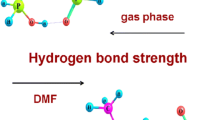Abstract
The PACHA (Partial Atomic Charges and Hardnesses Analysis) formalism is applied to polyoxometalate chemistry. Using the Ca2(H3O)2[V10O28]⋅16H2O crystal structure, it was shown that the relative affinity for protons of the various oxygen sites may be quantitatively determined. The charge distribution was also found to be in good agreement with 17O and 51V NMR measurements. The H-bond energy in this kind of compound was found to be about −17 kJ⋅mol−1, i.e., about 20% lower than in hexagonal ice. Finally, the 57 H-atom coordinates characterizing this structure were successfully recovered from a crystal structure optimization in the solid-state through electrostatic balance minimization. The importance of considering neutral clusters for a good modelization was demonstrated not only in the case of the decavanadate structure, but also in polysilicate chemistry. For the first time a clear picture emerges explaining the widespread occurrence of four- and five-membered rings in zeolite and silicate chemistry. The possibility of forming much larger polyanions with transition metal cations, is well explained using the crystal structure of the superfullerene keplerate [Mo132O372(HCO2)30(H2O)72]42− as a benchmark compound. The possibility of performing an ab-initio retrosynthetic analysis of this cage is demonstrated.
Similar content being viewed by others
Author information
Authors and Affiliations
Rights and permissions
About this article
Cite this article
Henry, M. Quantitative Modelization of Hydrogen-Bonding in Polyoxometalate Chemistry. Journal of Cluster Science 13, 437–458 (2002). https://doi.org/10.1023/A:1020559217894
Issue Date:
DOI: https://doi.org/10.1023/A:1020559217894




